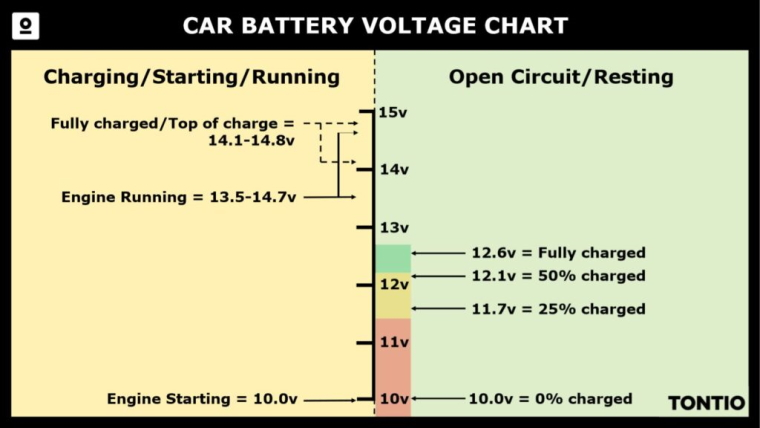What Voltage Should a Car Battery Be?
| Monday 10th July 2023 9:30am

Without a functioning car battery, you wouldn’t be able to automatically operate your car windows, lock your car doors from the inside, or keep music playing when you stop — among other things. For something that plays such a crucial role in the experience of operating a car, the battery is a really underestimated piece of equipment.
So much so that most drivers don’t even think about their battery, its health, or how much its voltage should be to keep their car running as it should day to day.
Aiming to do the humble battery justice, we’ve written this guide to voltage. Read on to find out what the correct voltage measurements for your car’s battery should be.
Car battery voltage explained
As we’ve said, not everyone is familiar with the inner workings of their car battery. So, let’s get acquainted. The battery is responsible for three things:
- Controlling any electrical components of your car when the engine isn’t running.
- Providing the ‘spark’ needed to get the engine moving when starting your car.
- Protecting against voltage spikes by stabilising the car’s circuit voltage when the engine is running.
When you start your car, the battery must provide the current that’s needed to get the starter motor going. In turn, this turns over the engine to get it running. At this point, the alternator can power the electrical systems or is, at least, providing the battery with the necessary charge to keep electrical systems running without depleting.
What is voltage exactly?
While we’ve mentioned voltage in passing, and you’re likely to have heard it used frequently before – what actually is voltage? The short answer is that voltage is the ‘pressure’ in a circuit.
A useful way to think about this is to compare it to a water system. Domestic mains water pipes are pressurised up to a certain point, but a tap provides enough “resistance” that no water comes out of it until you turn it on. When you turn it on, the amount of water that comes out is proportional to the size of the water pipes and the pressure that is being applied. A big pipe at the same pressure usually means more water.
Similarly, the voltage in an electric circuit is the ‘potential’ energy – the pressure that is potentially being applied when the circuit is allowed to flow. UK mains voltage is standardised to 230 volts.
When we talk about car battery voltage, we are usually talking about 12V batteries — that is, batteries that provide 12 volts under a nominal load. That being said, there are different types, you may come across van or leisure batteries, for example. The actual voltage you can measure, however, is likely to be quite different from 12 volts exactly.
For more detail, head over to our battery information page.
Why car battery voltage matters
Imagine this: you’re running late for work, you jog to the car, and go to start the ignition and nothing happens. The battery is flat. Maybe you left the interior light on overnight or maybe the battery died. For drivers everywhere, this is probably the most frustrating experience — especially if you don’t know how to jump start it or don’t own jump leads.
How could this situation have been avoided?
Keeping tabs on the voltage of your car’s battery is a surefire way to avoid any unnecessary battery failure, condition demise, or voltage spikes that may cause harm to your car’s electrical system. Find out how to check your battery health at home here.
What voltage should my car battery be?
When it comes to the ‘correct’ voltage for your car’s battery, there’s not really one straightforward answer we’re afraid. Why? Because your voltage will fluctuate based on the usage of your car — it will differ based on when your car is switched off, running, or starting. Let’s explore these differentiations now.
Engine off or ‘resting voltage’
When your car engine is turned off, a fully-charged car battery should have a voltage measurement of 12.6 volts, also known as resting voltage. This is enough to power certain electrical components in the car that need to have a memory (like your car’s clock) or things like your car’s alarm system.
When your car battery starts to run out of charge, the voltage levels drop. In the table below, the green areas show that you can use the battery at up to 40/50% of its charge without any consequences (like the engine not starting etc).
| Voltage in a 12-Volt Battery | Volts per Cell | State of Charge |
|---|---|---|
| 12.7 | 2.12 | 100% |
| 12.5 | 2.08 | 90% |
| 12.42 | 2.07 | 80% |
| 12.32 | 2.05 | 70% |
| 12.2 | 2.03 | 60% |
| 12.06 | 2.01 | 50% |
| 11.9 | 1.98 | 40% |
| 11.79 | 1.96 | 30% |
| 11.58 | 1.93 | 20% |
| 11.31 | 1.89 | 10% |
| 10.5 | 1.75 | 0% |
If you are measuring your car’s voltage, be sure to do so after it has been sat resting for 15-30 minutes in order to get an accurate reading. If the reading is below 12.6 volts, the battery isn’t fully charged.
Starting your engine
Contrary to what you might think, voltage levels are actually lower when you start your car. You may expect a sudden surge due to the energy needed to whir the car into life, but a healthy car battery will have around 10 volts when the engine is being started, before quickly escalating to the running voltage levels.
This drop in voltage happens because so much energy needs to be supplied to the starter motor in order to actually get the engine running. In cold weather, the voltage can even be lower as more power will be needed to start a cold engine.
Engine running
When your engine is ticking over, the battery voltage levels will rise to between 13.5 and 14.7 volts, boosted to this slightly higher level by the alternator.
If your battery is not charged up enough, the voltage levels it reaches will be significantly lower. Take a look at this handy table that summarises things nicely:

Image Credit: Car Battery Voltage Chart from Tonio
Don’t let your battery deplete too frequently
Car batteries will begin to ‘calcify’ if you let them deplete past a certain point too frequently. What this means in understandable terms is that they get irreparably damaged and aren’t able to store the same amount of power. Over time, or over a few really dramatic depletions, the battery may end up dying altogether.
Battery problems? Let Kwik Fit help
If you notice your battery isn’t performing as well as it should be, get in touch with the team at your local Kwik Fit or book in for your free battery health check where we’ll use our expert Bosch testing equipment to assess your battery and its starting and charging systems.
In the meantime, keep up to date with the Kwik Fit blog for the latest motoring news and advice.
Any facts, figures and prices shown in our blog articles are correct at time of publication.
Featured Articles
Is it Illegal to Drive With One Headlight?
Saturday 19th July 2025
Wondering if it’s illegal to drive with one headlight? Learn about the safety risks and penalties of illegal blown bulbs and why you should fix them promptly.
Air Con in EVs & Hybrids: Experts Answer Your Questions
Monday 30th June 2025
Does air con drain EV batteries? Can you use the air con while charging an electric car? Find out the answers to these questions & more from Kwik Fit’s experts.
Why Is Your Car Making a Noise? Fixes & Tips
Friday 13th June 2025
When your car starts making unexpected noises, it can certainly be quite disconcerting; it may be nothing to worry about, but here’s what you need to know.









